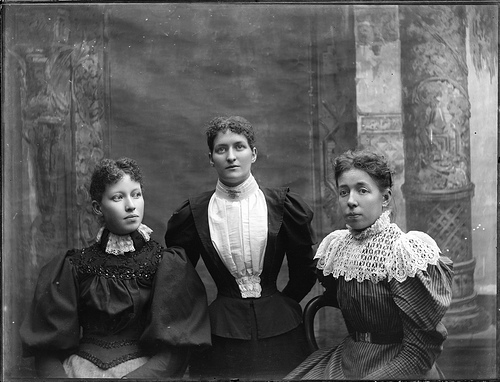by John Holbo on June 26, 2009
I like this pair of images from this ‘costume and dresses’ set.
Boadecia – Mother of England:

And these three women, sitting for a portrait:

Thought for the night: I find it very difficult to judge the age of people in old photos. Probably you’ve had the same experience. It reminds me of that section in Robert Musil, The Man Without Qualities, where he reflects on how faces go in and out of fashion. But partly it demonstrates – what is obviously at least half-true – that in judging people’s age we rely on deductions from their clothes and hair styles and such. (We know that such and such clothes are worn by 20-somethings, so someone dressed that way is probably 20-something.) But that doesn’t seem quite right either. Thoughts?
by John Holbo on June 26, 2009
OK, I’m fact-checking one last bit from my Plato book. I’m discussing the famous legend that over the door of Plato’s academy there was an inscription: ‘no non-geometers allowed’. Here’s a page that contains a bit of background if you are unaware of this legend (which is pretty weakly sourced to a commentary on a commentary on Aristotle, I think it is. So who knows.) Anyway, I mention in the text that there are religious overtones, which is most certainly true. But here’s my problem. I read somewhere that over the doors of Greek temples, or at the boundaries of certain holy areas – sites forbidden to those who are unclean, by the terms of Drako’s Law – ‘no unclean persons allowed’. I distinctly recall reading, specifically, that the unclean bit was ‘unjust’; that is, (I presume) ‘adikaios’. So take Plato’s ‘ageometros’, swap it out and plug in ‘adikaios’ and – bob’s your uncle – you’ve got the thing you might read over a temple door. Trouble is: I went back to footnote this bit and it wasn’t where I thought it was. So I’m wondering whether what I have in my book is strictly accurate. Are there surviving inscriptions that are almost like the one Plato is supposed to have put over his door, with only one word different? Or are there reliable reports of the existence of such inscriptions? It’s not a big deal, because the general point about religious overtones stands: the inscription forbids the ‘impure’ from entry, as Drako’s law forbids access to ‘the holy things’ to those who are presently ritually unclean (for whatever reason). But I don’t want my book sullied by the impure inclusion of an epigraphic untruth, Zeus forbid!
by Kieran Healy on June 26, 2009

